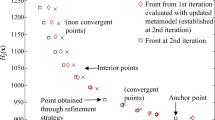Abstract
When cost per evaluation on a system of interest is high, surrogate systems can provide cheaper but lower-fidelity information. In the proposed extension of the sequential kriging optimization method, surrogate systems are exploited to reduce the total evaluation cost. The method utilizes data on all systems to build a kriging metamodel that provides a global prediction of the objective function and a measure of prediction uncertainty. The location and fidelity level of the next evaluation are selected by maximizing an augmented expected improvement function, which is connected with the evaluation costs. The proposed method was applied to test functions from the literature and a metal-forming process design problem via finite element simulations. The method manifests sensible search patterns, robust performance, and appreciable reduction in total evaluation cost as compared to the original method.
Similar content being viewed by others
References
Ackley DH (1987) A connectionist machine for genetic hill-climbing. Kluwer, Boston
Alexandrov NM, Dennis JE Jr, Lewis RM, Torczon V (1998) A trust region framework for managing the use of approximation models in optimization. Struct Optim 15(1):16–23
Audet C, Dennis JE Jr, Moore DW, Booker A, Frank PD (2000) A surrogate-model-based method for constrained optimization. In: Proceedings of the 8th AIAA/NASA/USAF/ISSMO symposium on multidisciplinary analysis and optimization, AIAA-2000-4891, Long Beach, 6–8 September 2000
Bandler JW, Ismail MA, Rayas-Sanchez JE, Zhang Q (1999) Neuromodelling of microwave circuits exploiting space-mapping technology. IEEE Trans Microwave Theor Tech 47:2417–2427
Björkman M, Holström K (2000) Global optimization of costly nonconvex functions using radial basis functions. Opt Eng 1:373–397
Cressie NAC (1993) Statistics for spatial data, revised edn. Wiley, New York
Currin C, Mitchell M, Morris M, Ylvisaker D (1991) Bayesian prediction of deterministic functions, with applications to the design and analysis of computer experiments. J Am Stat Assoc 86:953–963
Edy D, Averill RC, Punch WF III, Goodman ED (1998) Evaluation of injection island GA performance on flywheel design optimization. In: Parmee IC (ed) Adaptive computing in design and manufacture. Springer, Berlin Heidelberg New York
Hartman JK (1973) Some experiments in global optimization. Nav Res Logist Q 20:569–576
Huang D, Allen TT, Notz WI, Zheng N (2006) Global optimization of stochastic black-box systems via sequential kriging meta-models. J Global Optim 34(3):441–466
Hutchinson MG, Unger ER, Mason WH, Grossman B, Haftka RT (1994) Variable-complexity aerodynamic optimization of a high speed civil transport wing. J Aircr 31:110–116
Jones D, Schonlau M, Welch W (1998) Efficient global optimization of expensive black-box functions. J Global Optim 13:455–492
Kaufman M, Balabanov V, Burgee SL, Giunta AA, Grossman B, Mason WH, Watson LT (1996) Variable-complexity response surface approximations for wing structural weight in HSCT design. Proceedings of the 34th aerospace sciences meeting and exhibit, AIAA-96-0089, Reno, 15–18 January 1996
Keane AJ (2003) Wing optimization using design of experiment, response surface, and data fusion methods. J Aircr 40(4):741–750
Kennedy MC, O'Hagan A (2000) Predicting the output of a complex computer code when fast approximation are available. Biometrika 87(1):1–13
Kennedy MC, O'Hagan A (2001)Bayesian calibration of computer models (with discussion). J R Stat Soc, Ser B 63(3):425–464
Koehler JR, Owen AB (1996) Computer experiments. In: Ghosh S, Rao CR (eds) Handbook of statistics, vol 13. Elsevier, Amsterdam
Kushner HJ (1964) A new method of locating the maximum point of an arbitrary multipeak curve in the presence of noise. J Basic Eng 86:97–106
Leary SJ, Bhaskar A, Keane AJ (2003) A knowledge-based approach to response surface modelling in multifidelity optimization. J Global Optim 26(3):297–319
McDaniel WR, Ankenman BE (2000) A response surface test bed. Qual Reliab Eng Int 16:363–372
O'Hagan A (1989) Comment: design and analysis of computer experiments. Stat Sci 4:430–432
Rodriguez JF, Perez VM, Padmanabhan D, Renaud JE (2001) Sequential approximate optimization using multiple fidelity response surface approximation. Struct Multidisc Optim 22(1):23–34
Sacks J, Welch WJ, Mitchell TJ, Wynn HP (1989a) Design and analysis of computer experiments (with discussion). Stat Sci 4:409–430
Sacks J, Schiller SB, Welch W (1989b) Design for computer experiments. Technometrics 31:41–47
Santner TJ, Williams BJ, Notz WI (2003) The design and analysis of computer experiments. Springer, Berlin Heidelberg New York
Sasena MJ (2002) Flexibility and efficiency enhancements for constrained global design optimization with kriging approximations. Ph.D. dissertation, University of Michigan, Ann Arbor
Sasena MJ, Papalambros PY, Goovaerts P (2002) Exploration of metamodeling sampling criteria for constrained global optimization. Eng Optim 34:263–278
Schonlau M (1997) Computer experiments and global optimization. Ph.D. dissertation, University of Waterloo, Waterloo
Stein M (1987) Large sample properties of simulation using Latin hypercube sampling. Technometrics 29:143–151
Watson PM, Gupta KC (1996) EM-ANN models for microstrip vias and interconnects in dataset circuits. IEEE Trans Microwave Theor Tech 44:2495–2503
Author information
Authors and Affiliations
Corresponding author
Rights and permissions
About this article
Cite this article
Huang, D., Allen, T.T., Notz, W.I. et al. Sequential kriging optimization using multiple-fidelity evaluations. Struct Multidisc Optim 32, 369–382 (2006). https://doi.org/10.1007/s00158-005-0587-0
Received:
Revised:
Published:
Issue Date:
DOI: https://doi.org/10.1007/s00158-005-0587-0




